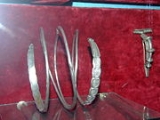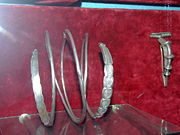
Decebalus Treasure
Encyclopedia
The Decebalus Treasure is a legendary story written by Cassius Dio concerning events said to have happened in the Roman world during the 2nd century AD.
, many nobles were caught and some surrounded, among them was one named Biklis (Bicilis), who showed the place were the treasure was hidden.

Decebalus
used Roman prisoners to deviate the course of the Sargetia river
and buried the treasure. He buried "so much silver and gold and some other artefacts who can survive moisture", after that the river was returned to its original course. The rest was of the treasure was deposited in surrounding caves, and the Roman prisoners were slaughtered.
historian compiling Getica
written by T. Statilius Crito
, Trajan
's medic, wrote that the Decebal Treasure had 5,000,000 lbs (2,200 tonne
s) of gold
and 10,000,000 lbs (4,500 tonnes) of silver
. Some modern historians, such as Julian Bennett believe that this is copy error. Still if the real treasure was one-tenth those figures, its value is still the equivalent of 160 million denarii.
Jérôme Carcopino
has estimated the treasure at 165,500 kg of gold and 331,000 kg of silver. Between 1540 and 1759 in Sarmizegetusa Regia 700 kg of gold was recovered, much more was discovered in the 19th century.
However, the Romans claim that they looted in a single hoard 165 tons of gold and 300 tons of silver is accepted by some historians. This amount is perhaps credible in terms of the massive Dacian exploitation of precious metals in the Apuseni Mountains along with trade payments and tributes from abroad paid to Dacians. Also, its existence in one spot suggests that Dacian State had a central control of precious metal circulation.
The story
During the Second Dacian WarSecond Dacian War
The Second Dacian War was fought in 105 to 106 because the Dacian king Decebalus had broken his peace terms with the Roman emperor Trajan from the First Dacian War...
, many nobles were caught and some surrounded, among them was one named Biklis (Bicilis), who showed the place were the treasure was hidden.

"The treasures of Decebalus were also discovered, though hidden beneath the river Sargetia, which ran past his palace. With the help of some captives Decebalus had diverted the course of the river, made an excavation in its bed, and into the cavity had thrown a large amount of silver and gold and other objects of great value that could stand a certain amount of moisture; then p389he had heaped stones over them and piled on earth, afterwards bringing the river back into his course. 5 He also had caused the same captives to deposit his robes and other articles of a like nature in caves, and after accomplishing this had made away with them to prevent them from disclosing anything. But Bicilis, a companion of his who knew what had been done, was seized and gave information about these things."
Decebalus
Decebalus
Decebalus or "The Brave" was a king of Dacia and is famous for fighting three wars and negotiating two interregnums of peace without being eliminated against the Roman Empire under two emperors...
used Roman prisoners to deviate the course of the Sargetia river
Strei River
The Strei River is a tributary of the Mureş River in Transylvania, Romania. It starts at the junction of headwaters Pârâul Cald and Pârâul Rovinei...
and buried the treasure. He buried "so much silver and gold and some other artefacts who can survive moisture", after that the river was returned to its original course. The rest was of the treasure was deposited in surrounding caves, and the Roman prisoners were slaughtered.
Sources
A ByzantineByzantine Empire
The Byzantine Empire was the Eastern Roman Empire during the periods of Late Antiquity and the Middle Ages, centred on the capital of Constantinople. Known simply as the Roman Empire or Romania to its inhabitants and neighbours, the Empire was the direct continuation of the Ancient Roman State...
historian compiling Getica
Criton of Heraclea
Criton of Heraclea was a 2nd century Greek chief physician and procurator of Roman Emperor Trajan in the campaign in Dacia....
written by T. Statilius Crito
Criton of Heraclea
Criton of Heraclea was a 2nd century Greek chief physician and procurator of Roman Emperor Trajan in the campaign in Dacia....
, Trajan
Trajan
Trajan , was Roman Emperor from 98 to 117 AD. Born into a non-patrician family in the province of Hispania Baetica, in Spain Trajan rose to prominence during the reign of emperor Domitian. Serving as a legatus legionis in Hispania Tarraconensis, in Spain, in 89 Trajan supported the emperor against...
's medic, wrote that the Decebal Treasure had 5,000,000 lbs (2,200 tonne
Tonne
The tonne, known as the metric ton in the US , often put pleonastically as "metric tonne" to avoid confusion with ton, is a metric system unit of mass equal to 1000 kilograms. The tonne is not an International System of Units unit, but is accepted for use with the SI...
s) of gold
Gold
Gold is a chemical element with the symbol Au and an atomic number of 79. Gold is a dense, soft, shiny, malleable and ductile metal. Pure gold has a bright yellow color and luster traditionally considered attractive, which it maintains without oxidizing in air or water. Chemically, gold is a...
and 10,000,000 lbs (4,500 tonnes) of silver
Silver
Silver is a metallic chemical element with the chemical symbol Ag and atomic number 47. A soft, white, lustrous transition metal, it has the highest electrical conductivity of any element and the highest thermal conductivity of any metal...
. Some modern historians, such as Julian Bennett believe that this is copy error. Still if the real treasure was one-tenth those figures, its value is still the equivalent of 160 million denarii.
Jérôme Carcopino
Jérôme Carcopino
Jérôme Carcopino was a French historian and author. He was the fifteen member elected to occupy seat 3 of the Académie française in 1955.-Biography:...
has estimated the treasure at 165,500 kg of gold and 331,000 kg of silver. Between 1540 and 1759 in Sarmizegetusa Regia 700 kg of gold was recovered, much more was discovered in the 19th century.
However, the Romans claim that they looted in a single hoard 165 tons of gold and 300 tons of silver is accepted by some historians. This amount is perhaps credible in terms of the massive Dacian exploitation of precious metals in the Apuseni Mountains along with trade payments and tributes from abroad paid to Dacians. Also, its existence in one spot suggests that Dacian State had a central control of precious metal circulation.

